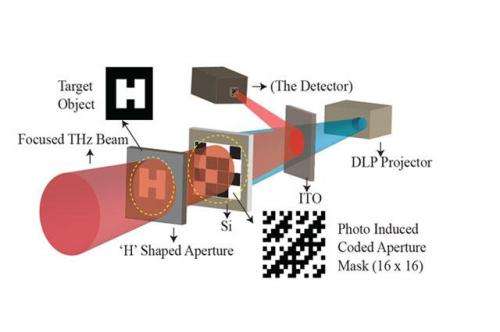Low cost and complexity real-time THz imaging may be within reach

Low cost and complexity real-time THz imaging may be within reach as work in the US combines commercially available digital light processing technology and compressed sensing to enhance coded aperture imaging.
Double time
Recent developments in THz imaging have led to new approaches for studying electron density and temperature fluctuations inside high-temperature plasmas; including electron cyclotron emission imaging and microwave imaging reflectometry. In this application, events of interest occur in milliseconds, requiring a high frame rate to observe them.
At the same time, real-time millimetre-wave to THz imaging has also become of interest for through-barrier imaging and aviation applications such as severe-weather operation. For example, THz imaging could allow pilots to see through atmospheric conditions like fog and sand. Here, the frame rate needed is lower, but it is critical that video frame rates can be produced in real-time.
Existing THz imaging systems generally fall into one of three categories: single-element imagers that obtain images by mechanical scanning; array imagers like focal-plane arrays (FPAs); and coded-aperture imaging (CAI).
In applications requiring very high frame rates, mechanical scanning is impractical. Array-based imagers like FPAs offer the highest imaging speed with high SNR, but tend to be complex and expensive, especially for large-scale arrays with high imaging resolution, as an antenna and low noise amplifier/receiver is needed for each pixel.
Building a view
CAI-based systems use spatial encoding and modulation to eliminate the need for detector arrays. A single THz detector in combination with a series of N × N coded aperture masks is employed to reconstruct an N × N resolution image of a target from the THz waves passing through the different masks. The concept has been demonstrated using fixed masks fabricated on PCBs, with 2D scanning to obtain imaging data through the masks.
For high frame rates, aperture arrays electronically actuated by Schottky diodes and graphene modulators have been proposed. But these approaches have similar cost and complexity issues to FPAs, requiring a diode/modulator and biasing line per pixel, and pre-patterned circuits (e.g., antenna arrays) for operation.
In the work reported in this issue, the team from the University of Notre Dame's THz circuits and systems research group report an approach to CAI THz imaging with the potential for real-time video performance but with low system cost and complexity.
Projections
The approach has two key features. The first is their method for producing the coded apertures. Instead of using a series of physical masks, their system projects 'apertures' on a plain un-patterned, semi-insulating Si substrate, using a commercial digital light processing (DLP) projector. "We found in earlier work that THz waves can be easily modulated using photo-induced free carriers. When light illuminates a semiconductor, free carriers are generated as long as the photon energy of the light exceeds the band gap energy of the semiconductor. The charge carrier density, and hence the photo conductivity and THz transmission, can be controlled by the energy density of the incident photons. We apply this to spatially modulate the THz wavefront and generate reconfigurable aperture arrays directly on the unpatterned Silicon wafer," explained team member Md. Itrat Bin Shams. For this reason, they describe their system as photo-induced CAI (PI-CAI) and it avoids the need for complex microfabrication processes and precise alignment of masks.
The second key feature is the use of compressed sensing (CS), reducing the frame acquisition time by at least 40%. They report that for a 256 pixel image, the use of CS reduces acquisition time from 24 to 14 seconds. That is, of course, still an apparently long way from the 24 frames per second that could be considered a video frame rate, but the team are confident that their results show video rates are within reach, and for much higher pixel counts.
"This acquisition time is limited by the relatively slow (1.3 kHz) DMD control electronics in the DLP. The approach can be improved using existing high-speed DMD chipsets and optimised data-acquisition software. For a 32 × 32 image frame, approximately 1229 masks are needed, and with a 32 kHz DMD 26 full frames can be collected in a second. We expect to demonstrate a real-time PI-CAI system in one year," said Shams. "A 1k pixel real-time THz imaging system would find a wide range of immediate applications. We would like to see these imagers applied in low-cost diagnostics (e.g. plasmas, quasi-optical systems) and rapid screening of skin disease and cancers."
The group at Notre Dame are using elements of this work in other research. They have applied PI-CAI to characterise micromachined THz horn antennas and are applying the THz wave spatial optical modulation mechanism to other tunable/reconfigurable quasi-optical THz devices, such as tuneable zone-plates, beam-steering antennas and, potentially, tuneable filters.
More information: The report, "Approaching real-time terahertz imaging with photo-induced coded apertures and compressed sensing," is available online: digital-library.theiet.org/con … 10.1049/el.2014.0993
Journal information: Electronics Letters
Provided by Institution of Engineering and Technology
This story is published courtesy of Electronics Letters. For additional Electronics Letters news and features visit theiet.org/eletters





















